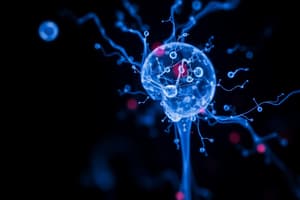Podcast
Questions and Answers
What is the difference between sensation and perception?
What is the difference between sensation and perception?
- Sensation is a cognitive process, while perception is purely physiological.
- Sensation involves the interpretation of sensory information, while perception is about the detection of stimuli.
- Sensation refers to the conscious awareness of sensory information, whereas perception occurs subconsciously.
- Sensation is the process of experiencing physical stimuli, while perception is the mental interpretation of those stimuli. (correct)
Which concept explains the minimum difference in stimulation that a person can detect 50% of the time?
Which concept explains the minimum difference in stimulation that a person can detect 50% of the time?
- Just noticeable difference (correct)
- Signal-detection theory
- Subliminal perception
- Absolute threshold
Which theory of color vision emphasizes the role of three types of cones in the retina?
Which theory of color vision emphasizes the role of three types of cones in the retina?
- Retinal disparity theory
- Opponent process theory
- Trichromatic theory (correct)
- Color constancy theory
What is the primary function of the human ear's cochlea?
What is the primary function of the human ear's cochlea?
Which of the following best describes bottom-up perception?
Which of the following best describes bottom-up perception?
What does the term 'absolute threshold' refer to in sensory processing?
What does the term 'absolute threshold' refer to in sensory processing?
What does the term 'just noticeable difference' (JND) imply?
What does the term 'just noticeable difference' (JND) imply?
According to Weber's Law, what does the size of a just noticeable difference depend on?
According to Weber's Law, what does the size of a just noticeable difference depend on?
How is sensation defined in the context of sensory processing?
How is sensation defined in the context of sensory processing?
Which of the following statements about perception is accurate?
Which of the following statements about perception is accurate?
Which example illustrates the concept of an absolute threshold?
Which example illustrates the concept of an absolute threshold?
In the context of Weber's Law, what would be an appropriate scenario illustrating the JND?
In the context of Weber's Law, what would be an appropriate scenario illustrating the JND?
What does the trichromatic theory of colour vision propose?
What does the trichromatic theory of colour vision propose?
Which type of colour blindness involves the inability to distinguish between one of the primary colours?
Which type of colour blindness involves the inability to distinguish between one of the primary colours?
What concept describes pairs of colours that produce grey tones when mixed?
What concept describes pairs of colours that produce grey tones when mixed?
What visual phenomenon occurs after staring at a colour stimulus and then looking away?
What visual phenomenon occurs after staring at a colour stimulus and then looking away?
Which term describes a type of drawing that can be interpreted in multiple ways?
Which term describes a type of drawing that can be interpreted in multiple ways?
What is meant by the term 'perceptual set'?
What is meant by the term 'perceptual set'?
What do opponent process theories suggest about colour perception?
What do opponent process theories suggest about colour perception?
Which phenomenon illustrates the subjectivity of perception?
Which phenomenon illustrates the subjectivity of perception?
What does signal-detection theory suggest about the detection of stimuli?
What does signal-detection theory suggest about the detection of stimuli?
What is subliminal perception?
What is subliminal perception?
What is the primary function of the lens in the human eye?
What is the primary function of the lens in the human eye?
What is the role of cones in the human visual system?
What is the role of cones in the human visual system?
How does sensory adaptation affect perception?
How does sensory adaptation affect perception?
Which part of the retina has the highest density of cones?
Which part of the retina has the highest density of cones?
What occurs during dark adaptation in the human eye?
What occurs during dark adaptation in the human eye?
What is the effect of the pupil constricting?
What is the effect of the pupil constricting?
Which of the following statements about light adaptation is correct?
Which of the following statements about light adaptation is correct?
Flashcards
Absolute Threshold
Absolute Threshold
The minimum amount of stimulus energy needed to detect a stimulus 50% of the time.
Sensory Adaptation
Sensory Adaptation
The decrease in sensitivity to a constant stimulus over time.
Trichromatic vs Opponent-Process Theories of Color Vision
Trichromatic vs Opponent-Process Theories of Color Vision
Two different ways the brain processes color: First, three types of color receptor cells, and second, color receptors working in opponent pairs.
Bottom-up vs Top-down Perception
Bottom-up vs Top-down Perception
Signup and view all the flashcards
Gestalt Principles
Gestalt Principles
Signup and view all the flashcards
Just Noticeable Difference (JND)
Just Noticeable Difference (JND)
Signup and view all the flashcards
Weber's Law
Weber's Law
Signup and view all the flashcards
Sensation
Sensation
Signup and view all the flashcards
Perception
Perception
Signup and view all the flashcards
Sensory Input
Sensory Input
Signup and view all the flashcards
Difference Threshold
Difference Threshold
Signup and view all the flashcards
Signal Detection Theory
Signal Detection Theory
Signup and view all the flashcards
Criterion
Criterion
Signup and view all the flashcards
Hits, Misses, False Alarms, Correct Rejections
Hits, Misses, False Alarms, Correct Rejections
Signup and view all the flashcards
Subliminal Perception
Subliminal Perception
Signup and view all the flashcards
Amplitude of Light
Amplitude of Light
Signup and view all the flashcards
Wavelength of Light
Wavelength of Light
Signup and view all the flashcards
Purity of Light
Purity of Light
Signup and view all the flashcards
Accommodation
Accommodation
Signup and view all the flashcards
Trichromatic Theory
Trichromatic Theory
Signup and view all the flashcards
Opponent-Process Theory
Opponent-Process Theory
Signup and view all the flashcards
Color Blindness
Color Blindness
Signup and view all the flashcards
Dichromats
Dichromats
Signup and view all the flashcards
Complementary Colors
Complementary Colors
Signup and view all the flashcards
Afterimage
Afterimage
Signup and view all the flashcards
Reversible Figure
Reversible Figure
Signup and view all the flashcards
Perceptual Set
Perceptual Set
Signup and view all the flashcards
Subjective Perception
Subjective Perception
Signup and view all the flashcards
Study Notes
Sensation and Perception
-
Sensation is the detection of stimuli, a bottom-up process. It involves the stimulation of sense organs (e.g., eyes, ears) by energy (e.g., light, sound).
-
Perception is the translation of sensory information into meaningful experiences. It's a top-down process, involving the selection, organization, and interpretation of sensory input.
Key Concepts and Terms
-
Absolute Threshold: Smallest amount of stimulation needed to detect a stimulus half of the time; defines the limits of sensory abilities.
-
Just Noticeable Difference (JND): Smallest difference between two stimuli that can be detected half of the time. Weber's Law states the JND is a constant proportion (not a fixed amount) of the initial stimulus.
-
Signal Detection Theory: Stimulus detection depends on both sensory processes and decision processes (e.g., expectations, criteria).
-
Subliminal Perception: Sensory input below the threshold of conscious awareness.
-
Sensory Adaptation: Gradual decrease in sensitivity to a constant stimulus.
-
Vision: Processes include color mixing (additive and subtractive), theories (trichromatic and opponent process), and vision for perception/action. Structures of the eye (cornea, pupil, lens, retina, rods, cones, etc.) and processes involved in light/dark adaptation, and receptive fields are involved.
-
Hearing: Mechanisms include place theory and frequency theory, describing how sound waves are translated into neural signals. Structures include outer ear (pinna, auditory canal), middle ear (eardrum, hammer, anvil, stirrup), and inner ear (cochlea, basilar membrane).
-
Gustation (Taste) and Olfaction (Smell): Chemical substances trigger taste and smell, involving specific receptors and pathways to the brain.
-
Tactile (Touch): Receptors in the skin detect pressure, temperature, and pain, with various types present (Merkel cells, Meissner corpuscles, Ruffini endings, Pacinian corpuscles).
Gestalt Principles
-
Phi Phenomenon: Illusion of movement from rapidly presented stimuli.
-
Proximity: Grouping nearby objects together.
-
Similarity: Grouping similar objects together.
-
Closure: Filling in gaps to perceive complete shapes.
-
Continuity: Following continuous patterns.
-
Perceptual Hypothesis: Drawing inferences about distal stimuli based on proximal stimuli.
-
Monocular and Binocular Cues: Techniques used to judge distance and depth (monocular cues use one eye, binocular cues use both). Examples include linear perspective, texture gradient, and interposition.
Top-Down vs. Bottom-Up Processing
- Bottom-up: Information processing that begins with sensory receptors and works up to higher levels of processing.
- Top-down: Processing guided by your experiences and expectations that influences perception.
Studying That Suits You
Use AI to generate personalized quizzes and flashcards to suit your learning preferences.
Related Documents
Description
Explore the fundamental concepts of sensation and perception in psychology. This quiz covers key terms such as absolute threshold, just noticeable difference, and signal detection theory, helping you understand how we interpret sensory information. Test your knowledge to enhance your grasp of these essential psychological processes.




